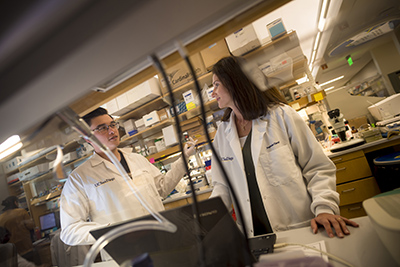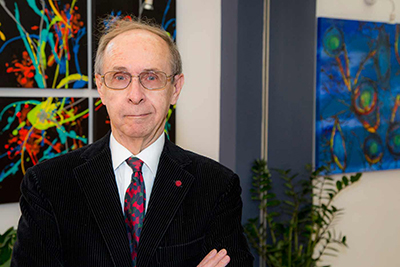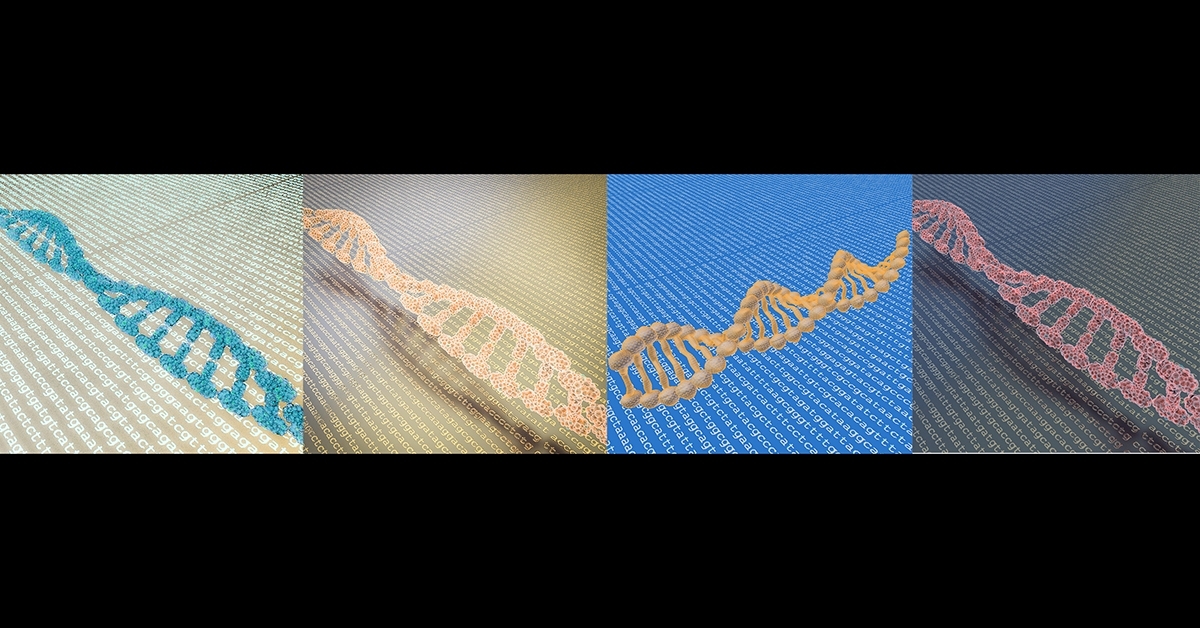Gene Therapy Finds New Life in an Old Home
For decades, UC San Diego has been a hub for gene therapy research; an upcoming symposium highlights the translation of that approach into clinical trials and actual treatments
Story by:
Published Date
Story by:
Topics covered:
Share This:
Article Content
The idea of gene therapy is simple: Repair or replace a defective gene to treat or cure the disease caused by that abnormality. The reality of gene therapy, however, is more complicated and has proven much harder to achieve.
Perhaps only now, after decades of work, is the promise of gene therapy truly blossoming into practice, with scores of diverse genetic diseases being treated or seriously investigated.
Some of these efforts will be highlighted in a symposium November 17-18, 2022 at UC San Diego, in which researchers and physicians will discuss current clinical trials using gene therapy, here and abroad. The event, open to students, faculty and industry (registration/fee required), is hosted by UC San Diego School of Medicine, the Embassy of France in the United States and Assistance Publique-Hôpitaux de Paris as part of French-American Innovation Days.

“For some genetic disorders, like cystinosis, gene therapy may offer the only real path to a cure, and the only way to prove it is through clinical trials,” said Stephanie Cherqui, PhD, professor of pediatrics at UC San Diego School of Medicine and one of the symposium organizers. “The symposium is a meeting of like-minded minds, an opportunity to discuss clinical trials in gene therapy on both a local and international scale.”
Cherqui specializes in the study and treatment of cystinosis, a condition caused by a genetic mutation of the CTNS gene, resulting in an abnormal accumulation of the amino acid cystine in organs and tissues. Without treatment, patients usually develop end-stage kidney failure and die prematurely. Standard of care involves drugs used to lower cellular cystine levels, but treatment can only delay disease progression.
Cherqui is overseeing a novel Phase I/II clinical trial in which patients’ hematopoietic stem cells (the precursors to all blood cell types) are re-engineered using gene therapy techniques to introduce a normal version of the CTNS gene into the stem cells, which are then re-infused into the patients.
The therapy was developed by Cherqui and colleagues at UC San Diego. The first participant in the trial was treated in January 2020. The last of six trial patients was admitted last month.
Institutional genes
Theodore Friedmann, MD, is a Distinguished Professor Emeritus of Pediatrics at UC San Diego School of Medicine. Another title is “father of gene therapy,” an acclamation he received in 2015 when he was awarded the prestigious Japan Prize for his pioneering research and contributions to the development of gene therapy.
In significant ways, the concepts and early technology underlying human gene therapy originated at UC San Diego with scientists like Friedmann.
In 1968, Friedmann, then working at the National Institutes of Health in Bethesda, Maryland with Jay Seegmiller (a founding faculty member of the UC San Diego School of Medicine) and John Subak-Sharpe, showed that by adding foreign normal DNA to cultured cells from patients with Lesch-Nyhan syndrome, they could correct genetic defects that caused the rare but devastating neurological disorder. The syndrome was first described by William Nyhan, MD, a UC San Diego professor of pediatrics, and medical student Michael Lesch in 1964.

Four years later, Friedmann, now a visiting scientist at the Salk Institute for Biological Sciences in La Jolla, and Richard Roblin published a foundational article in the journal Science under the heading “Gene therapy for human genetic disease?”
They argued that the emerging science presented a new way to ameliorate some human genetic diseases. Many agreed. Public imagination was fueled by optimistic promises. In the 1990s, Friedmann helped established a human gene therapy program at UC San Diego, one of only a handful such academic-based centers in the nation, but efforts everywhere to translate proofs-of-concept into clinical realities were slow and results mixed.
Critics questioned the ethics of tinkering with the basic building blocks of life, of scientists playing God. Robust clinical trials were limited, and frequently inconclusive. In one high profile trial, a participant died, the death attributed to gene therapy manipulations combined with problematic experimental treatment design. Public and scientific enthusiasm and support waned.
It has returned. In recent years, researchers in Europe (notably France) and elsewhere have reported measurable success using gene therapy to treat several genetic disorders. Friedmann said it’s a matter of science and technology catching up to a good idea.
“Technology has gotten better. Disease models have expanded. The science is more rigorous,” said Friedmann, who is now writing a history on the origins and development of gene therapy. “The field has grown and matured. We have moved past having to prove the concept. We have overcome an early history of promising too much too soon. We are now actually developing and delivering real treatments for real people.”
That’s evident at UC San Diego, where a diverse group of scientists and physicians are exploring the potential of gene therapy to treat myriad conditions, from head and neck cancer to genetic defects of the central nervous system to pediatric conditions like cystinosis and Danon disease, the latter an inherited condition characterized by progressive weakening of body muscles, especially the heart.
“Danon disease is a death sentence without treatment,” said Eric Adler, MD, a cardiologist and director of cardiac transplant and mechanical circulatory support at UC San Diego Health. “Current standard of care is heart transplant or die by age 25. My goal is to change the standard of care.”
Adler and colleagues have developed a gene therapy to do just that, adding a modified gene to patients to repair dysfunction caused mutations in a gene called LAMP2. A national trial, co-led by Barry Greenberg, MD, cardiologist and professor of medicine at UC San Diego School of Medicine, launched in 2019 and is slated to run to October 2024.
Danon disease is extraordinarily rare, estimated to affect fewer than 1,000 persons in the U.S., though for many the condition is undiagnosed. Researchers are exploring how to use gene therapy for much more common health afflictions.
“Gene therapy is part of the standard of care for certain treatments in cancer already,” said Sandip Patel, MD, a medical oncologist at UC San Diego Health. “For example, CAR-T cell therapy, which is used in some treatments of leukemia, lymphoma and myeloma, requires gene therapy to engineer a patient’s own immune cells to fight their cancer. Similar methods are now being explored in clinical trials for solid tumors as well.”
Long but looming
The attraction of gene therapy is elemental. All living organisms rely upon genetic information to guide development, survival and the quality of existence. Good health requires good information.
“For neurodevelopment genetic disorders, gene therapy acts on the very root of the problem, the specific genetic component involved in the problem. It is as close to a cure as you can get,” said Alysson R. Muotri, PhD, a professor of pediatrics and cellular and molecular medicine who is using gene therapy and human brain organoids to explore potential treatments for Pitt-Hopkins Syndrome, a very rare autism spectrum disorder characterized by developmental delays and moderate to severe intellectual disability.
The eye is an ideal target organ for gene therapy, said Shyamanga Borooah, MD, ophthalmologist at Shiley Eye Institute and an assistant professor of ophthalmology, because it is easy to access and monitor, separated from systemic circulation and relatively immunosuppressed.
Borooah oversees a clinic that diagnoses and treats patients with retinal, macular and inherited diseases. Like Muotri, he uses gene therapy to test novel treatments in stem cell models of eye “diseases in a dish.”
“Gene therapy has had a profound impact in my precision ophthalmology and ophthalmic genetics clinic,” said Borooah. “Previously, the main function of the clinic was to diagnose patients and provide low-vision support. Now the paradigm has shifted, and the question is often which treatment or which gene therapy trial can patients can participate in. Gene therapy has not only given hope, but has also restored vision in specific cases.”
Currently, the FDA lists roughly two dozen approved cellular and gene therapy products targeting some cancers, blood diseases and inherited conditions. Some are revolutionary, said Mark Tuszynski, MD, PhD, Distinguished Professor of Neurosciences and director of the Translational Neuroscience Institute at UC San Diego School of Medicine.
In 2019, for example, the FDA approved a gene therapy to treat children with spinal muscular atrophy, a progressive weakening of muscles that is the leading genetic cause of infant mortality. In young patients with early-onset disease, the median survival is just seven months.
“Gene therapy has converted a uniformly fatal disease into a treatable disease,” said Tuszynski. “Infants used to die by age two; now most of these children survive and are able to gain strength. This is the great potential of gene therapy.”
Tuszynski’s gene therapy research has focused on addressing genetic health issues at the other end of life: Alzheimer’s disease.
In 2021, he and colleagues announced a first-in-human Phase I clinical trial to assess the safety and efficacy of a gene therapy to deliver a key protein into the brains of persons with Alzheimer’s disease or Mild Cognitive Impairment, a condition that often precedes full-blown dementia. The protein is a growth factor, intended to reverse the loss of neurons and connections associated with advancing dementia. The trial runs through 2027.
After decades overcoming hurdles, recovering from missteps and unrealistic expectations, gene therapy advocates can now point to actual successes. And they believe gene therapy’s potential is not yet fully tapped.
To be sure, much research remains to be done. Gene therapy is still typically only available as part of a clinical trial at places like UC San Diego.
“And that’s why leading researchers conducting clinical trials in gene therapy are gathering here,” said Cherqui. “This is a place with experience and expertise.”
For information and registration regarding the Clinical Trials in Gene Therapy symposium at UC San Diego, November 17-18, visit French-American Innovation Days-gene therapy. To view clinical trials at UC San Diego, visit UC San Diego Health/Clinical Trials.
You May Also Like
Engineers Take a Closer Look at How a Plant Virus Primes the Immune System to Fight Cancer
Technology & EngineeringStay in the Know
Keep up with all the latest from UC San Diego. Subscribe to the newsletter today.




